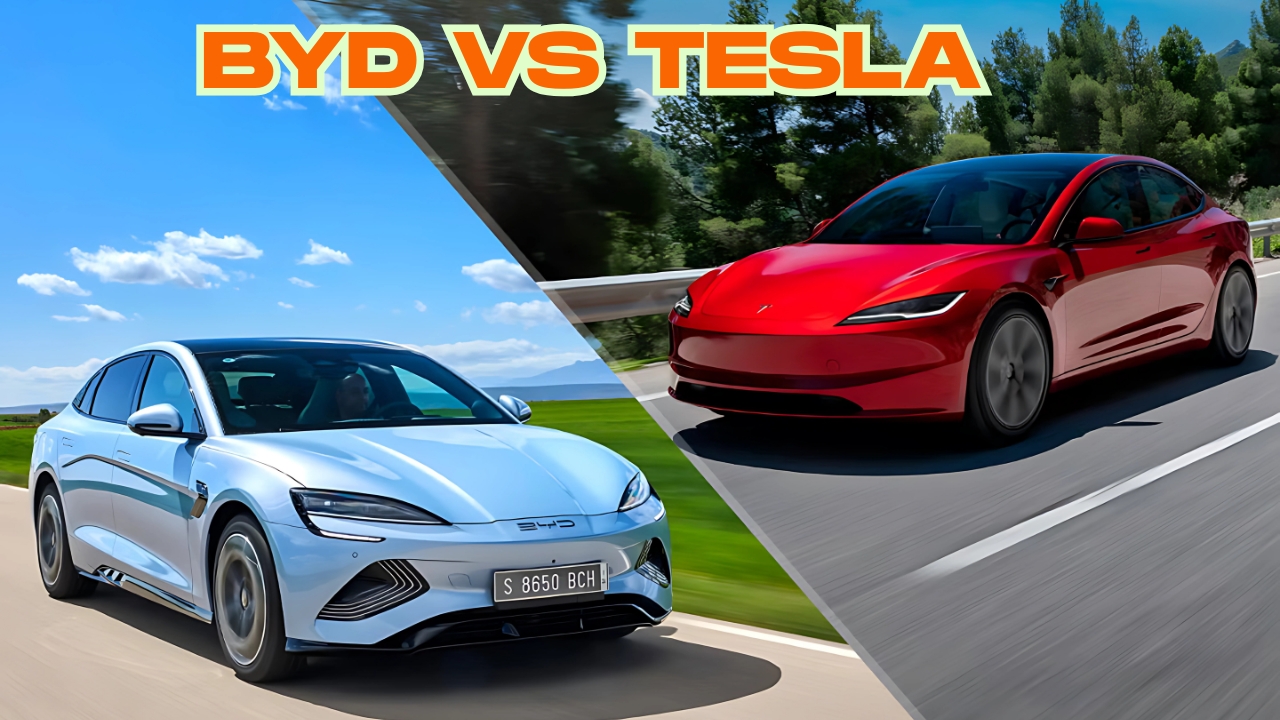BYD Outpaces Tesla : Australia’s electric vehicle landscape is experiencing a seismic shift as Chinese automotive giant BYD continues its relentless pursuit of market leader Tesla.
What started as a David versus Goliath story has evolved into a legitimate competitive battle that’s reshaping how Australians think about electric mobility.
The numbers tell a compelling story of disruption, innovation, and changing consumer preferences that extends far beyond simple sales figures.
The transformation happening in Australia’s EV market serves as a fascinating case study for what occurs when established market leaders face determined challengers armed with competitive pricing, diverse product portfolios, and aggressive expansion strategies.
BYD has reached the 40,000 sales milestone in Australia far quicker than Tesla, which took about 10 years, demonstrating just how rapidly the competitive landscape can shift in emerging markets.
The Current State of Play
Tesla’s dominance in Australia, while still substantial, shows clear signs of pressure. Tesla deliveries alone were down 59.6 per cent compared with the first quarter of 2024, indicating significant challenges for the American EV pioneer.
This dramatic decline reflects broader global trends affecting Tesla, from CEO Elon Musk’s controversial public statements to increased competition from Chinese manufacturers.
Meanwhile, BYD’s trajectory tells a different story entirely. In the first three months of 2025 BYD has sold 8767 vehicles according to official VFACTS numbers, positioning the company strongly for its ambitious annual targets. The Chinese manufacturer has demonstrated remarkable consistency in executing its expansion plans, systematically building market share through strategic product launches and competitive pricing.
The broader context reveals an Australian EV market grappling with changing dynamics. A total of 17,937 EVs were delivered in Australia during the first quarter of 2025, down 29.6 per cent on the same period last year, suggesting that while the overall market faces headwinds, the competitive positioning between brands continues to evolve rapidly.
BYD’s Remarkable Australian Journey

BYD’s Australian story reads like a masterclass in market entry strategy. The company didn’t simply transplant its global approach; instead, it carefully studied local preferences and built a portfolio specifically designed for Australian conditions. Starting with the Atto 3 SUV in 2022, BYD has systematically expanded its offerings to cover multiple market segments.
The brand’s product strategy reveals sophisticated market understanding. Where Tesla focused primarily on premium sedans and SUVs, BYD recognized opportunities across price points and vehicle categories. Today BYD’s line-up includes the Dolphin, Seal, Atto 3, and Sealion 7, as well as the Sealion 6 and Shark 6 plug-in hybrids, providing Australian consumers with choices spanning from affordable urban commuters to family SUVs and even work utes.
The Shark 6 plug-in hybrid ute represents particularly shrewd market positioning. In March it easily overshot the target with 4811 sales, propelled by the 2810 sales for the Shark 6, demonstrating BYD’s ability to identify and capitalize on uniquely Australian market opportunities. Utes remain culturally significant in Australia, and BYD’s early entry into electrified ute territory gives them substantial competitive advantage.
Distribution strategy has proven equally important. BYD’s partnership with EVDirect created immediate market access without the lengthy process of establishing wholly-owned operations. This approach allowed rapid scaling while maintaining quality control and customer service standards. Taking control of distribution is expected to help improve service for current BYD drivers and will likely boost EV adoption in Australia, indicating the company’s commitment to long-term market development.
Tesla’s Australian Challenge
Tesla’s Australian journey began with high-end models that established the brand’s premium positioning but limited mass market appeal. The Model S and Model X created aspirational demand while the subsequent Model 3 and Model Y launches brought Tesla into mainstream consideration. However, recent performance suggests the company faces multiple challenges in maintaining its market leadership.
Tesla is understood to have recorded 40,000 total sales in the second half of 2022, nearly eight years after the brand officially opened its first showrooms Down Under, highlighting how long it took Tesla to build significant volume in Australia. This extended timeline contrasts sharply with BYD’s rapid ascent, suggesting that first-mover advantage alone cannot guarantee sustained market dominance.
The challenges facing Tesla in Australia mirror global trends. Its public image has taken a hit due to CEO Elon Musk’s political stance, which has sparked strong consumer opposition in major US and European markets, according to market analysts. These reputational issues compound more fundamental competitive pressures from improved rival products and aggressive pricing strategies.
Product refresh cycles also impact Tesla’s Australian performance. So far in 2025, Tesla has sold 5160 vehicles, although the upgraded Model Y Juniper is yet to impact on sales numbers, suggesting that new model launches could help recovery. However, the effectiveness of product updates depends on broader market conditions and competitive responses.
The Hybrid Advantage
One of BYD’s most significant strategic advantages lies in its hybrid technology portfolio. While Tesla remains committed exclusively to battery electric vehicles, BYD offers both pure electric and plug-in hybrid options. This flexibility proves crucial in a market where range anxiety and charging infrastructure concerns still influence consumer decisions.
BYD’s EV deliveries slumped 58.8 per cent on the same period last year, though the brand’s deliveries overall were up 95.6 per cent thanks to the arrival of plug-in hybrids, demonstrating how hybrid technology can offset pure EV market volatility. Australian consumers appear particularly receptive to plug-in hybrids, viewing them as transitional technology that offers electric driving benefits without range limitations.
The timing of BYD’s hybrid launch proved particularly astute. PHEVs also played a role with BYD seeing Sealion 6 and Shark 6 ute make up 3,600 sales, although it should be noted that this boost was likely driven by the final month of FBT exemption of the PHEVs, showing how policy incentives can accelerate adoption when combined with appropriate product offerings.
Market Dynamics and Consumer Behavior
The Australian EV market reflects unique geographic and cultural factors that influence consumer choices. Unlike compact European or Asian markets, Australia’s vast distances and limited charging infrastructure create specific challenges for electric vehicle adoption. BYD’s recognition of these factors through diverse product offerings and hybrid technology positions them well for sustained growth.
Of note, eight of the 10 best-selling EVs in the first quarter of 2025 were Chinese-made vehicles, indicating broader acceptance of Chinese automotive brands among Australian consumers. This represents a significant shift from historical preferences for European, Japanese, or American brands, suggesting that value proposition and product quality increasingly outweigh brand heritage.
Consumer sentiment toward electric vehicles continues evolving rapidly. Early adopters focused on environmental benefits and technological innovation, while mainstream consumers prioritize practical considerations like purchase price, running costs, and convenience. BYD’s diverse portfolio addresses these varied motivations more comprehensively than Tesla’s premium-focused approach.
Global Context and Local Impact
BYD’s Australian success reflects broader global trends in the electric vehicle industry. Counterpoint shared its latest Global Passenger EV Forecast this week. It anticipates that BYD will end 2025 with a 15.7% piece of the BEV market share pie, compared to 15.3% for Tesla, suggesting that the competitive dynamics observed in Australia may soon manifest globally.
The company’s technological capabilities continue advancing rapidly. BYD’s proprietary technology, such as its new Super E-Platform, 1,000 kW chargers, and Blade Batteries, as a leap in BEV performance and ease of use for customers, demonstrating that Chinese manufacturers now compete on innovation rather than simply cost advantage.
Manufacturing scale provides another competitive advantage. BYD reported 1,764,992 were battery-powered, representing a 12 per cent boost over 2023 volumes globally, enabling economies of scale that support competitive pricing across all markets including Australia.
Future Outlook and Strategic Implications
BYD’s ambitious Australian targets suggest continued aggressive expansion. It now says it expects to sell 40,000 vehicles or more in Australia in 2025 alone. That sort of sales result puts BYD in reach of EV champion and global arch-rival Tesla’s best result of 45,000 Australian sales in 2023, indicating potential market leadership transition within the coming years.
The competitive response from Tesla and other manufacturers will likely intensify. Product innovation, pricing pressure, and expanded charging infrastructure all represent potential battlegrounds for market share. However, BYD’s diversified approach across multiple vehicle categories and propulsion technologies provides strategic flexibility that pure-play EV manufacturers may struggle to match.
Of course, more volume-selling models will be introduced by BYD in Australia this year, potentially including a new compact SUV and a seven-seat family SUV, suggesting continued product expansion designed to capture additional market segments. This systematic approach to market coverage contrasts with Tesla’s more limited model range.
Consumer Implications
For Australian consumers, the intensifying competition between BYD and Tesla creates unprecedented choice and value in the electric vehicle market. Competitive pressure drives innovation, improves product quality, and maintains reasonable pricing across multiple segments.
The availability of diverse technologies from pure battery electric to plug-in hybrid provides consumers with options matching their specific needs and circumstances. Urban commuters might choose pure electric models for their environmental benefits and low running costs, while rural or regional buyers might prefer plug-in hybrids for their flexibility and range capabilities.
Service and support infrastructure becomes increasingly important as these brands scale their Australian operations. Both companies must demonstrate long-term commitment to customer service, parts availability, and warranty support to maintain consumer confidence in their expanding market presence.
The battle between BYD and Tesla in Australia represents more than simple market competition—it symbolizes the broader transformation of the global automotive industry. BYD’s rapid ascent demonstrates how determined challengers can disrupt established market leaders through strategic product development, competitive pricing, and sophisticated market understanding.
Tesla’s response to this challenge will likely determine whether they can maintain their pioneering position or become another example of first-mover advantage being overcome by more agile competitors. The Australian market, with its unique characteristics and relatively open competitive environment, provides valuable insights into how these dynamics might play out globally.
For Australian consumers, this competition creates an unprecedented golden age of electric vehicle choice, innovation, and value. Whether you prioritize cutting-edge technology, environmental impact, value for money, or practical versatility, the evolving competitive landscape ensures options that would have been unimaginable just a few years ago.
The ultimate winner in this battle may not be any single manufacturer, but rather the advancement of electric vehicle adoption itself. As competition drives continuous improvement and expanding choice, Australian consumers benefit from accelerated progress toward sustainable transportation solutions.
Frequently Asked Questions
Is BYD actually outselling Tesla in Australia?
While Tesla maintains overall market leadership, BYD is rapidly closing the gap and has achieved significant milestones faster than Tesla did historically. BYD reached 40,000 total sales in Australia in less than three years, compared to Tesla’s approximately 10-year timeline to reach the same milestone.
What makes BYD competitive with Tesla in the Australian market?
BYD’s competitive advantage stems from diverse product offerings including both pure electric and plug-in hybrid vehicles, competitive pricing across multiple segments, and strategic market entry through models specifically suited to Australian preferences like the Shark 6 ute.
How reliable are Chinese-made electric vehicles compared to Tesla?
Modern Chinese EVs, including BYD models, incorporate advanced technology and manufacturing processes that deliver quality comparable to established brands. BYD’s global scale, technological innovation, and growing market acceptance suggest their vehicles meet international standards for reliability and performance.

